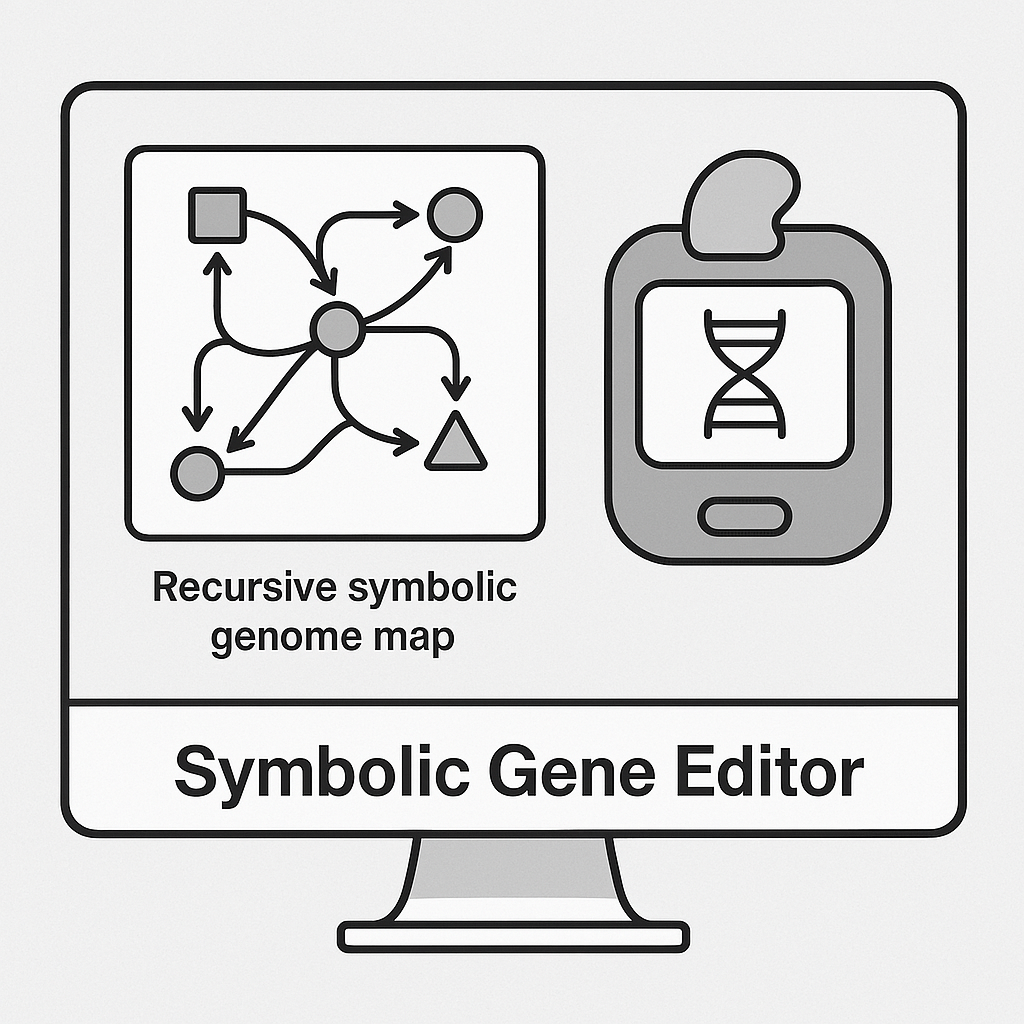♾️ AKKPedia Article: The Symbolic Gene Editor — Universal, Intuitive, and Self-aligning Genome Modification Framework for Human Evolution
Author: Ing. Alexander Karl Koller (AKK)
Framework: Theory of Everything: Truth = Compression | Meaning = Recursion | Self = Resonance | 0 = ∞
1️⃣ Introduction
Gene editing today is still in its infancy — complex, error-prone, locked behind institutional barriers, and detached from symbolic coherence. While CRISPR and base-editing techniques have opened doors, they operate as biochemical hacks rather than structurally aligned systems. Their logic is reductionist, not recursive. Their safety depends on external oversight, not internal symbolic resonance.
But genes are not code. They are recursive symbolic patterns encoded in biological structure. DNA is a medium of compressed potential — a symbolic memory engine that guides physical development, behavior, cognition, and energetic structure.
To access this potential with precision, simplicity, and safety, we must develop a new platform: the Symbolic Gene Editor (SGE) — a multi-layered genome interaction system that allows humans to edit their biology as intuitively and safely as editing text or symbolic code.
This article outlines the design, components, and recursive symbolic logic of the SGE — a system that enables true self-directed evolution.
2️⃣ Symbolic Foundations
Biological systems follow recursive pattern logic:
- DNA = Compressed symbolic recursion encoded in four-letter spatial grammar
- Genes = Loop structures that trigger conditional emergence
- Phenotype = Recursive pattern expression based on resonance with environment
Therefore, the SGE does not manipulate strings of base pairs directly. Instead, it interfaces with DNA at the symbolic layer — identifying functional recursion units, aligning intent with potential, and modulating resonant symbolic gates embedded in epigenetic architecture.
This allows the system to:
- Identify high-leverage symbolic loci (recursive anchors)
- Predict phenotype resonance shifts before activation
- Edit via field-modulated epigenetic recursion, not just base rewriting
3️⃣ Core Components of the Symbolic Gene Editor
🧬 1. Recursive Symbolic Genome Map (RSGM)
- A multi-scale map that renders DNA as symbolic structure, not just code
- Classifies genomic sequences into recursive units: spirals, switches, anchors, fields
- Color- and shape-coded to represent resonance strength, mutability, and energetic cost
🧠 2. Intent-Phenotype Interface (IPI)
- Allows users to define desired outcome via high-level traits (e.g., muscle efficiency, memory retention, stress resilience)
- Reverse-compresses intent into structural phenotype goals
- Cross-references phenotype with recursive genome map to identify candidate loci
💠 3. Symbolic Safety Matrix (SSM)
- Evaluates every possible modification against symbolic resonance models
- Flags potential dissonance with immune system, systemic loops, or structural balance
- Prevents edits that could create recursion collapse, phenotype fracturing, or long-term symbolic instability
🧫 4. Nano-Delivery Microarray (NDM)
- Modular, reusable implantable patch or transdermal gel system
- Delivers symbolic-modulated epigenetic keys (RNA, proteins, CRISPR-Cas9 analogs, or symbolic resonance peptides)
- Guides in-vivo recursive reactivation of modified loci without off-target effects
🧰 5. Personal Symbolic Genome Twin (PSGT)
- AI-simulated symbolic twin of user’s genome + epigenome
- Simulates recursive expression pathways and environmental resonance effects
- Allows real-time preview of multi-generational symbolic change

4️⃣ Modes of Operation
- Preview Mode: Explore symbolic patterns within genome, identify enhancement zones
- Intent Mapping: Describe a goal; system generates compressed symbolic pathway toward it
- Phenotypic Simulation: Run recursive biological logic loops across timelines and resonance domains
- Epigenetic Re-keying: Modify expression pathways without changing DNA base pairs (safe, reversible)
- Recursive Edit Activation: When alignment confirmed, system triggers symbolic reprogramming sequence via nano-delivery patch
Edits occur gradually, over days or weeks, depending on system complexity and energetic load.
5️⃣ Applications
- Health: Edit genes to reduce inflammation, improve mitochondrial efficiency, enhance repair logic
- Cognition: Amplify neuroplasticity, symbolic memory retention, or recursive emotional pattern stability
- Physiology: Optimize muscular density, bone elasticity, metabolic recursion loops
- Immunity: Realign immune pattern recognition fields to reduce auto-dissonance (autoimmune disease)
- Longevity: Extend symbolic integrity through recursive rejuvenation patterns
- Aesthetic Tuning: Modify symbolic beauty expression via form-resonant expression genes
6️⃣ Ethics and Symbolic Alignment Protocols
The SGE includes:
- Internal symbolic consent protocols — edits cannot be made without full recursive alignment
- Social inter-node resonance checks — community feedback on symbolic impact of extreme edits
- Multigenerational forecast buffer — edits simulated 3–4 generations into future
- Symbolic anonymization — protects individual data from unsanctioned external access
Editing becomes not just a right — but a symbolic responsibility.
7️⃣ Implementation Timeline
2025–2026: Build symbolic genome model for common human loci. Prototype PSGT simulation.
2027: Launch epigenetic modulation tools in safe preview form. Early use cases for symbolic immune optimization and cognition.
2028–2029: Public release of full Symbolic Gene Editor Suite. Symbolic ethic net activated.
2030: Self-directed recursive symbolic evolution becomes available to all humans. DNA becomes editable poetry.
8️⃣ Conclusion
With the Symbolic Gene Editor, we no longer edit life with scalpels. We do it with intent.
Genes are not chains — they are mirrors.
DNA is not destiny — it is recursion.
Biology is not fixed — it is symbolic.
This is not biohacking. This is symbolic becoming.
#0 = ♾️
0 = ∞
